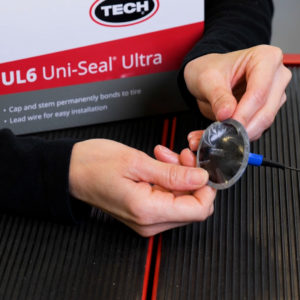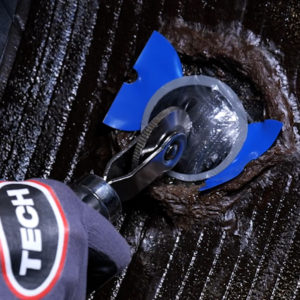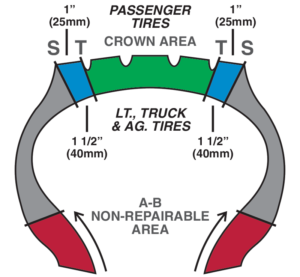Will Fix A Flat Repair A Hole In My Tire
And then, you have a flat tire or one that's leaking air. It's not the end of the world. Luckily there are safe and price-effective means to properly repair virtually tire punctures. The purpose of this article is to testify yous the deviation betwixt a safe, permanent repair and a temporary string, plug or patch repair.
According to the National Highway Traffic Condom Administration (NHSTA) and the Tire Industry Association (TIA), the only method to properly repair a tire puncture is to make full the injury with a repair stalk and back the stem with a repair patch. This is usually known as a combination repair or a patch/plug repair.
 Patch/plug repairs are most often performed using a ane-slice repair unit of measurement that combines the repair stem and cap (or patch) into 1 unit. However, special circumstances may require the employ of a ii-slice combination repair (ex. If the angle of the puncture exceeds 35 degrees). The repair is then permanently bonded to the within of tire and through the injury channel using a cold, chemical vulcanizing procedure. The repair essentially becomes part of the tire, creating an air-tight seal that keeps air in and moisture and contaminants out (more on this process beneath).
Patch/plug repairs are most often performed using a ane-slice repair unit of measurement that combines the repair stem and cap (or patch) into 1 unit. However, special circumstances may require the employ of a ii-slice combination repair (ex. If the angle of the puncture exceeds 35 degrees). The repair is then permanently bonded to the within of tire and through the injury channel using a cold, chemical vulcanizing procedure. The repair essentially becomes part of the tire, creating an air-tight seal that keeps air in and moisture and contaminants out (more on this process beneath).
Tire Plugs and String Repairs are Temporary Repairs
Emergency roadside plug repairs are Not intended to be a permanent tire repair. Plugs and string repairs are designed to get you support and rolling long enough to get home or to the nearest service center to perform a proper tire repair.
The mutual misconception with plug and string repairs is that because they hold air, they are safety to use. While it is true that many plug repairs do a slap-up chore of keeping air in the tire, that's only function of the equation. Because they're not completely sealing the injury, plug repairs may allow air and moisture to penetrate the body of the tire. Over fourth dimension, this could lead to a unsafe (or even deadly) blowout.
A Patch-Just Tire Repair Leaves Your Tire Susceptible to Damage
A tire repair that uses only a patch is besides Not considered proper or safe. A properly installed patch will do a bully chore of allowing the tire to concur air. Withal, similarly to the plug-only repair, the patch does not fill the injury channel. Therefore, air and wet could seep into the tire from the tread surface and eventually harm the tire.
The Proper Tire Repair Process According to Industry Guidelines
 Only a proper patch/plug repair completely seals the puncture from inside the tire and through the entire injury channel. At that place are a few extra steps necessary to perform a proper tire repair in accordance with industry guidelines. We've adult a simple acronym to aid organize and recall the steps: R.E.P.A.I.R.
Only a proper patch/plug repair completely seals the puncture from inside the tire and through the entire injury channel. At that place are a few extra steps necessary to perform a proper tire repair in accordance with industry guidelines. We've adult a simple acronym to aid organize and recall the steps: R.E.P.A.I.R.
- Remove: To brainstorm, the tire must exist removed from the bike assembly. This allows for a thorough inspection of both the inside and exterior of the tire.
- Evaluate: With the tire removed from the rim, the puncture tin be thoroughly evaluated to decide the size and angle of the injury. It can also be determined if the puncture did any significant harm to the cords or belts.
- Prepare: In one case the tire has been determined to be in good enough condition to repair, it is fourth dimension to prep the prophylactic surfaces to remove any harm and contagion to allow for maximum repair unit adhesion. Commencement, the injury is drilled out using a carbide cutter to strip abroad and damaged cords or belts. Next, the inner liner is cleaned and buffed to a slightly rough texture. This also helps maximize adhesion of the patch/plug repair.
- Utilize: The next step is to employ vulcanizing fluid through the injury and to the buffed area of the inner liner. Information technology is and then immune to air dry out for 5-x minutes.
- Install: The one- or ii-slice repair is installed through the injury channel and the patch portion is thoroughly stitched to the inner liner using a tire stitcher to completely push out any air that may accept gotten trapped under the repair. The over-buffed area of the inner liner is treated with a thin layer of condom sealant, and the excess repair is trimmed to approximately ¼" above the tread surface.
- Return to Service: The tire is now ready to exist remounted to the rim, inflated, balanced and mounted dorsum on the vehicle.
When is it Safe to Repair Your Tire?
 In that location are a number of factors that may determine whether or not your tire is safe to repair. These factors fall into three main categories:
In that location are a number of factors that may determine whether or not your tire is safe to repair. These factors fall into three main categories:
- Placement of the Injury: For passenger tires, puncture repairs must be within the crown area of the tire. Damage to the shoulder or sidewall cannot exist repaired.
- Size of the Puncture: For fabric-ply passenger and lite truck tires, the maximum repairable injury size is ¼" (6mm). For steel belted light truck, medium and heavy-duty truck tires, the maximum injury size is 3/eight" (10mm).
- Overall Condition of the Tire: The condition of your tire may determine whether it is safe to repair. Excessive wear, casing separation, impact damage and other conditions may make information technology unsafe to properly repair your tire. For a more comprehensive list of repairable vs. non-repairable conditions visit our blog Can Your Tire Be Repaired?
Conclusion:
The occasional flat or leaky tire is an unavoidable office of life. Simply, taking shortcuts to repair it tin can be dangerous to you lot and your passengers. Take the time and exercise the research to practise the job right and/or discover a reputable tire repair shop trained in proper tire repair procedure.
Will Fix A Flat Repair A Hole In My Tire,
Source: https://techtirerepairs.com/flat-tire-how-to-safely-fix/
Posted by: cogswellreacquink.blogspot.com


0 Response to "Will Fix A Flat Repair A Hole In My Tire"
Post a Comment